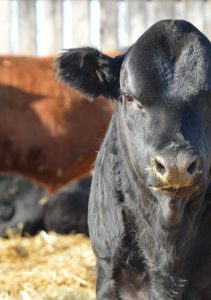Top 10 Blog Posts of 2019
This past year we published 78 blog posts that offered production tips and decision tools, provided a science-based perspective on issues in the media, highlighted new beef, cattle and forage research projects and results, and announced other exciting initiatives. Of those, these were the top 10 most popular:

10) Three Producers Share Ideas That Improve Efficiency
Beef producers across the country are always looking to improve management and production practices that not only benefit cattle, but also reduce their workload, and help to save time and money. This article highlights 3 producers and a recent change they have made to improve efficiency on their operations those changes include improved calf identification measures, installing remote cameras to monitor watering systems, and adopting quiet livestock handling practices in a flexible year-round grazing system.
http://www.beefresearch.ca/blog/three-producers-share-ideas-that-improve-efficiency/

9) Replacement Heifers – Money, Management, and Momentum
Do you raise your own heifers? Or do you prefer to purchase your replacements? Regardless of your choice, developing heifers costs money and requires careful management. This article outlines some of the pro’s and cons of raising vs. buying in heifers.
http://www.beefresearch.ca/blog/replacement-heifers-money-management-and-momentum/

8) The Cost-Benefit of Using Vaccines: Bovine Respiratory Disease
Bovine respiratory disease (BRD) is one of the costliest health issues facing the beef industry today. While a lot of research on BRD has been focused at the feedlot stage, the disease is also the most common cause of death for nursing calves older than three weeks. Once calves are affected by BRD, there are both immediate and long-lasting effects on performance. The Cost-Benefit of Feeding BRD Vaccinated Calves tool allows producers to input their own numbers of feeder cattle purchased (or retained), feeder and fed price, weight, cost of gain, days on feed and treatment cost to calculate and compare the expense of feeding calves that have not been vaccinated for BRD.
http://www.beefresearch.ca/blog/the-cost-benefit-of-using-vaccines-bovine-respiratory-disease/

7) How to Increase Your Odds of Having Healthy Calves
Calving is a natural process, but sometimes disease, weather, and many other factors can cause stress. How can beef producers best prepare newborn calves to get a healthy start? What are some effective changes you can make to enable calves to be resilient against bugs like bacteria, viruses or other pathogens they will encounter?
http://www.beefresearch.ca/blog/how-to-increase-your-odds-of-having-healthy-calves/

6) Beef’s Place in A Healthy Environment: Infographic
Cutting back on the amount of beef Canadians consume has been suggested in the media and public conversations online as a strategy to help save the planet. This recommendation may be based on the erroneous belief that Canadian land is inappropriately or inefficiently used in order to produce beef, but it certainly overlooks the positive impacts that a healthy beef sector has on the environment. This blog post contains the infographic titled ‘Beef’s Place in a Healthy Environment.” http://www.beefresearch.ca/blog/beefs-place-in-a-healthy-environment-infographic/

5) How to Get New Feedlot Calves Settled and Gaining Quickly; Advice from Producers, Veterinarians and Feedlot Consultants
Getting calves settled, keeping them healthy and getting them gaining is critical to improved animal health and reduced costs in a feedlot. In this article you will hear from feedlot vets, managers, and nutritionists on how they make the transition period easier on calves. http://www.beefresearch.ca/blog/how-to-get-new-feedlot-calves-settled-and-gaining-quickly-advice-from-producers-veterinarians-and-feedlot-consultants/

4) Unintended Consequences
Shifting from winter to spring calving has improved the health and survival of beef calves in Western Canada. Calving on pasture reduces disease spread, and fresh grass supports colostrum and milk production. Late spring calving avoids more snowstorms and death losses. But breeding cows in late summer (for late spring calving) may reduce pregnancy rates because pasture conditions and nutritional value are starting to decline.
http://www.beefresearch.ca/blog/unintended-consequences/

3) Bull Selection: New Calculator to Determine the Value of a Bull
To estimate breakeven bull price, a bull valuation calculator has been developed. The purpose is to allow you to run the numbers from your operation to determine how much you should be willing to pay for a bull. This is part 4 of a 4-part series on bull selection.
http://www.beefresearch.ca/blog/bull-selection-new-calculator-to-determine-the-value-of-a-bull/

2) Winter Feeding Cost Comparison – Hay Vs. Alternative Feeds
Winter feed costs are the largest variable cost for cow-calf production. Poor weather in some areas has led to increased availability and falling prices of alternative feeds meaning you may want to price out some different feed sources this winter. You can use the BCRC’s decision making tool ‘Winter Feeding Rations and Estimated Costs’ to calculate and compare the costs of main feed ingredients in different rations.
http://www.beefresearch.ca/blog/winter-feeding-cost-comparison-hay-vs-alternative-feeds/

1) Isn’t Beef Canada’s Ultimate Plant Based Protein?
As plant-based protein options become more abundant, people can’t help but wonder how they compare to meat. Is producing plant-based proteins better for the environment than livestock? Are meatless options healthier? Should I replace beef burgers with plant-based patties? This article provides a mix of facts on how beef production provides unique environmental and human health benefits.
http://www.beefresearch.ca/blog/isnt-beef-canadas-ultimate-plant-based-protein/
Click here to subscribe to the BCRC Blog and receive email notifications when new content is posted.
The sharing or reprinting of BCRC Blog articles is welcome and encouraged. Please provide acknowledgement to the Beef Cattle Research Council, list the website address, www.BeefResearch.ca, and let us know you chose to share the article by emailing us at [email protected].
We welcome your questions, comments and suggestions. Contact us directly or generate public discussion by posting your thoughts below.